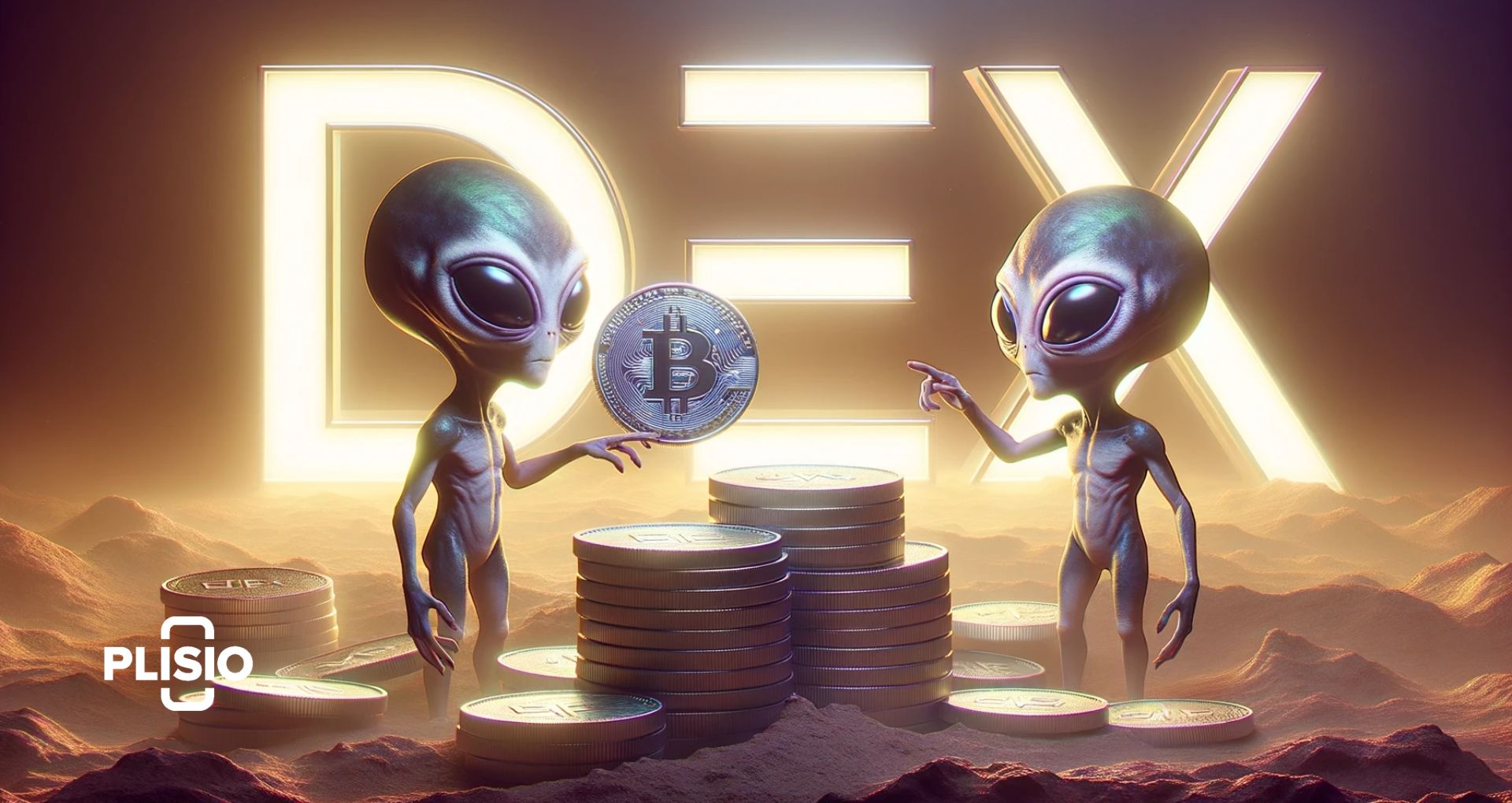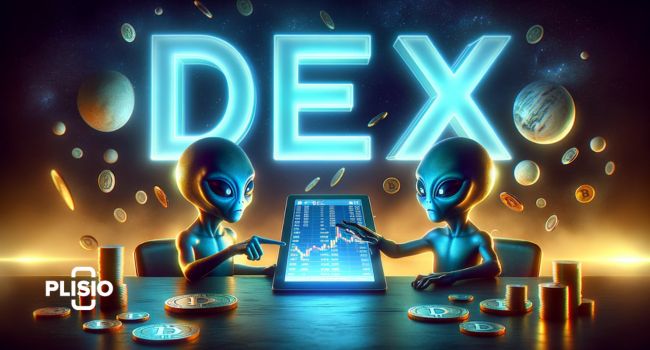What Is a DEX (Decentralized Exchange)?

Decentralized exchanges, commonly referred to as DEXs, represent a revolutionary shift in how cryptocurrencies are traded. These platforms operate as peer-to-peer marketplaces, eliminating the need for intermediaries such as banks, brokers, or payment processors. By leveraging blockchain technology and smart contracts, DEXs enable users to trade directly with one another.
In the traditional financial ecosystem, transactions are typically obscured by intermediaries, giving limited insight into their operations. DEXs, in contrast, offer a lens of transparency into fund movements and trading mechanisms. This transparent nature is underpinned by self-executing agreements known as smart contracts.
Furthermore, the non-custodial nature of DEXs ensures users retain control over their wallet's private keys, providing an advanced encryption layer to access their assets. This system removes the counterparty risks associated with centralization and keeps the user in control. It's a notable advantage, especially for individuals who value privacy and don’t wish to disclose personal details.
One of the significant accelerants for the DEX revolution has been the innovations in addressing liquidity challenges. Tools like automated market makers have played a pivotal role in attracting users to the DeFi realm, catalyzing its exponential growth. Moreover, the advent of DEX aggregators and wallet extensions has optimized token prices, swap fees, and minimized slippage, invariably offering users enhanced rates.
In the broader perspective of DeFi, DEXs serve as foundational building blocks. These platforms provide a base upon which more intricate financial products can be innovatively constructed, harnessing the power of permissionless composability in the blockchain universe.

What are decentralized exchanges?
Decentralized exchanges, commonly known as DEXs, operate by harnessing the power of blockchain and smart contracts. This framework empowers users to execute trades directly without the intervention of a centralized body. In essence, DEXs are designed to let the blockchain and its algorithms take over the role traditionally played by intermediaries.
Contrastingly, centralized exchanges function under the aegis of established institutions, often resembling traditional financial entities like banks. Their dominant presence in the crypto trading sphere is attributed to their regulated nature, which gives many traders a sense of security. These platforms take custody of users' assets and often lure newcomers with their intuitive interfaces. A noteworthy feature of some elite centralized exchanges is their insurance coverage on user deposits, which adds an extra layer of safety.
Drawing parallels, the services rendered by centralized exchanges can be likened to conventional banks. They act as custodians, safeguarding clients' funds and offering a suite of security measures that would be challenging for individual users to implement. Centralized platforms simplify the processes of trading and transferring assets.
Conversely, DEXs usher in an era of true peer-to-peer transactions, facilitated through smart contracts. They grant users the autonomy to trade directly from personal wallets, imbuing a sense of control but also responsibility. The onus is on traders to safeguard their assets, making them accountable for lapses like misplacing private keys or erroneous transfers.
On DEXs, when assets are deposited, users receive an "IOU" – a tokenized representation of their deposited value. This IOU, rooted in blockchain technology, mirrors the value of the underlying asset and can be traded across the network seamlessly.
Many prominent DEXs have found their foundation atop major blockchains that enable smart contract functionalities. Specifically, these DEXs are constructed on layer-one protocols, signifying their direct integration with the blockchain itself. Ethereum, given its versatility and robust smart contract capabilities, remains the primary choice for the majority of today's top DEX platforms.

How do DEXs work?
Decentralized exchanges (DEXs) have emerged as a groundbreaking innovation in the crypto world, enabling users to trade assets without relying on a centralized authority. Unlike centralized exchanges (CEXs) such as Coinbase, which operate via an internal database and can facilitate fiat-to-crypto conversions, DEXs function purely through smart contracts on blockchains. They trade exclusively in cryptocurrency pairs and maintain no internal order books.
There are primarily three types of DEXs: Automated Market Makers (AMMs), Order Book DEXs, and DEX Aggregators.
Automated Market Makers (AMMs):
AMMs are a prevalent DEX model. They don't rely on the traditional order book system. Instead, they use liquidity pools where assets are pre-funded by users, who in turn receive a share of transaction fees, a mechanism often referred to as liquidity mining. The price of assets in AMMs is determined algorithmically based on the proportion of tokens in the pool. While AMMs offer instant liquidity, they can also experience slippage, especially during significant trades. Liquidity providers in AMMs might face risks like impermanent loss.
Order Book DEXs:
Traditional order books are the foundation of many electronic exchanges, recording open buy and sell orders. On-chain order book DEXs require every interaction to be posted on the blockchain, while off-chain order book DEXs only settle trades on-chain. This makes the latter faster and less costly. These platforms may also offer leveraged trading, where users can amplify their positions using borrowed funds. However, the need to interact with blockchain and associated fees can make some traders prefer centralized platforms.
DEX Aggregators:
Aggregators search through multiple DEXs on-chain to offer users optimal trade conditions. By pulling liquidity from numerous sources, they aim to minimize slippage, optimize fees, and provide the best possible prices. Some aggregators even draw liquidity from centralized platforms, leveraging integrations while maintaining a non-custodial stance.
All DEX designs aim for high decentralization, utilizing blockchain technology for its immutable nature. However, achieving this without compromising competitiveness is challenging. While DEXs give users control over their funds and offer a level of transparency unmatched by centralized exchanges, they also come with network and trading fees. The vision behind many DEXs is to promote a decentralized infrastructure governed by a community of stakeholders through decentralized autonomous organizations (DAOs).
What are potential benefits of using a DEX?
Trading on decentralized exchanges (DEXs) offers a wide array of benefits, both in terms of token availability and user security. These platforms allow for unparalleled access to a vast variety of tokens, from established ones to emerging and lesser-known projects. This extensive range is due to the ease with which anyone can mint a token on platforms like Ethereum and subsequently establish a liquidity pool for it on DEXs. However, this advantage also has its drawbacks, as the absence of rigorous vetting processes means that scams like "rug pulls" can be prevalent.
Another significant appeal of DEXs is the preservation of user anonymity. Unlike their centralized counterparts, which necessitate users to undergo a detailed Know Your Customer (KYC) procedure, DEXs typically allow for trading without divulging personal details. This feature not only ensures privacy but also makes DEXs especially valuable in regions where a robust banking infrastructure might be lacking. For anyone with a smartphone and internet connectivity, DEXs provide an accessible trading avenue.
Moreover, security concerns that often plague centralized platforms are less pronounced on DEXs. Since traders maintain custody of their funds in their wallets and only interact with DEXs for executing trades, the chances of large-scale hacks are considerably reduced. Additionally, the inherent design of DEXs, which operates without intermediaries and relies on smart contracts, effectively nullifies counterparty risks. However, it's essential for users to conduct due diligence, like checking if a DEX's smart contracts have undergone audits, to ensure they're interacting with trustworthy platforms.
In essence, while DEXs usher in a new age of trading with vast token variety and enhanced security features, users must navigate these platforms with caution and informed decision-making.
Disadvantages of using DEXs
Decentralized exchanges (DEXs) have emerged as a cornerstone of the crypto trading ecosystem, democratizing access to trading and facilitating transparency. However, with the benefits come a range of challenges and risks that users should be aware of.
Navigating the DEX Environment:
DEX interfaces often come with a steep learning curve. Users, especially those new to the crypto realm, might find it overwhelming. Knowledge gaps can lead to mistakes like sending coins to the wrong wallet or mismanaging slippage. Research and understanding are pivotal. Many users might need to seek guidance from external resources or community forums, given the lack of hand-holding typical of DEX platforms.
Smart Contract Concerns:
While blockchains are robust and secure, the efficacy of smart contracts on DEXs is contingent on the expertise of the developers behind them. Bugs, vulnerabilities, and potential exploits can occasionally slip through even the most rigorous audits, putting users' funds at risk. It's crucial for users to understand that even well-intended smart contracts might have unforeseen vulnerabilities, especially when exposed to rare events or creative hack attempts.
Liquidity and Trading Challenges:
Certain DEXs, despite their growing popularity, suffer from liquidity issues. This lack of liquidity can lead to significant slippage, affecting the trading experience. Additionally, the openness of blockchain transactions can leave users vulnerable to frontrunning by bots seeking arbitrage opportunities.
Token and Project Due Diligence:
The permissionless nature of DEXs means a plethora of tokens can be listed, including those from early-stage projects. While this offers a diverse range of investment opportunities, it also exposes traders to potential scams, such as rug pulls. Users must be proactive in their research—exploring white papers, joining project communities, and checking for audits—before investing in any token.
Infrastructure and Centralization Hurdles:
Contrary to the decentralized ideal, some elements of DEXs can exhibit centralization tendencies, like the matching engine being on centralized servers or developers retaining undue influence over the platform's contracts. Additionally, network congestion or outages can impede trading, subjecting users to market volatilities.
Responsibility and Control:
Web3 promises users full control over their assets, a concept both empowering and daunting. While many relish the idea of managing their private keys and assets, it's a responsibility that requires careful attention to security protocols and best practices.
In sum, while DEXs usher in a new era of trading, marked by autonomy and openness, they also introduce complexities and risks. Users must be diligent, informed, and cautious as they navigate this dynamic landscape.

How do DEX fees work?
Fees on decentralized exchanges are subject to change. For instance, Uniswap levies a 0.3% fee, which is distributed among its liquidity providers. There's also a possibility that an additional protocol fee might be introduced in the coming times. However, users should be aware that the fees set by the DEX are often overshadowed by the gas fees associated with Ethereum network transactions. Efforts like the ETH2 upgrade, along with Layer 2 solutions such as Optimism and Polygon, aim to mitigate these high costs by enhancing the network's efficiency, thereby aiming to reduce fees and accelerate transaction processing times.
